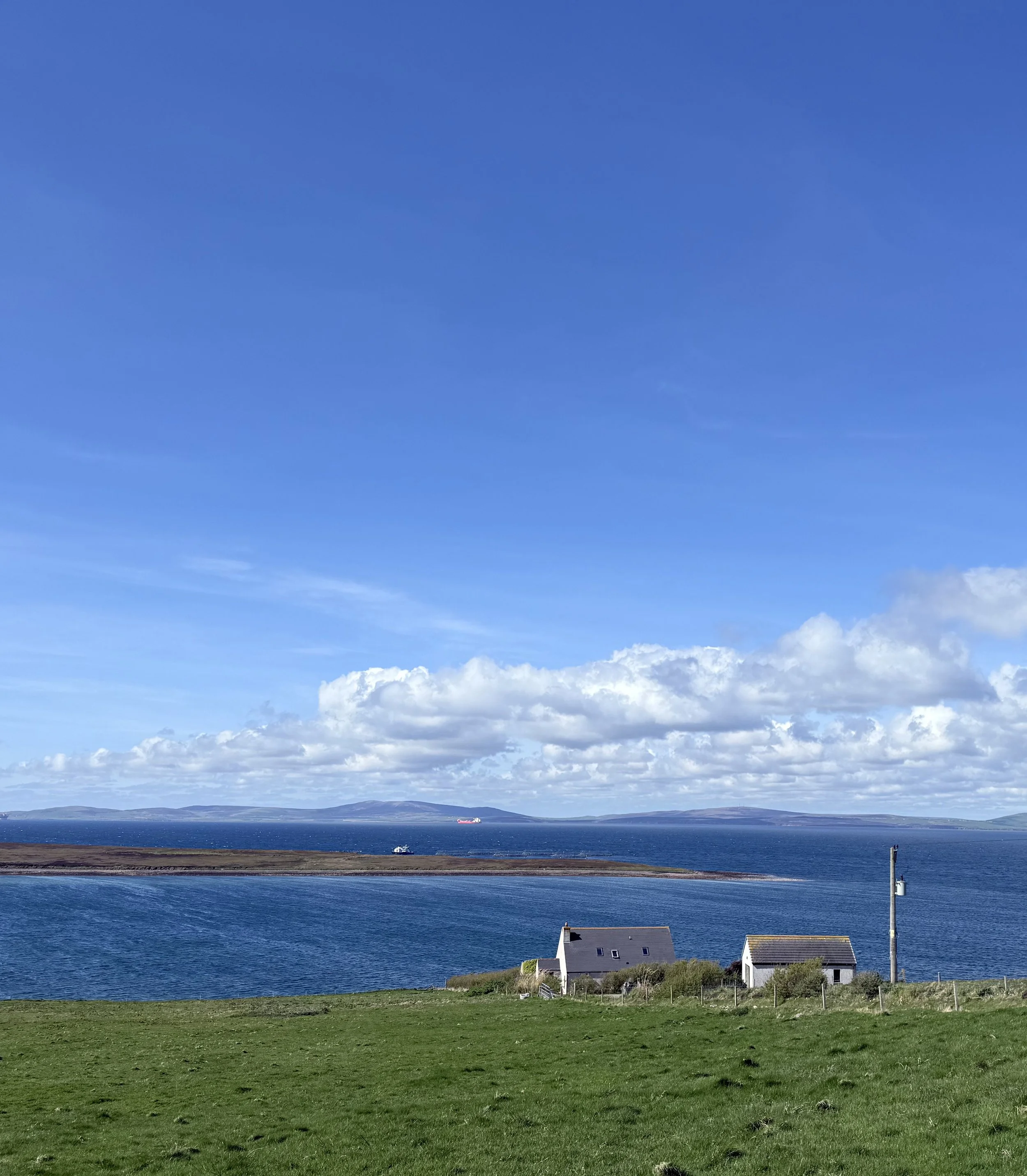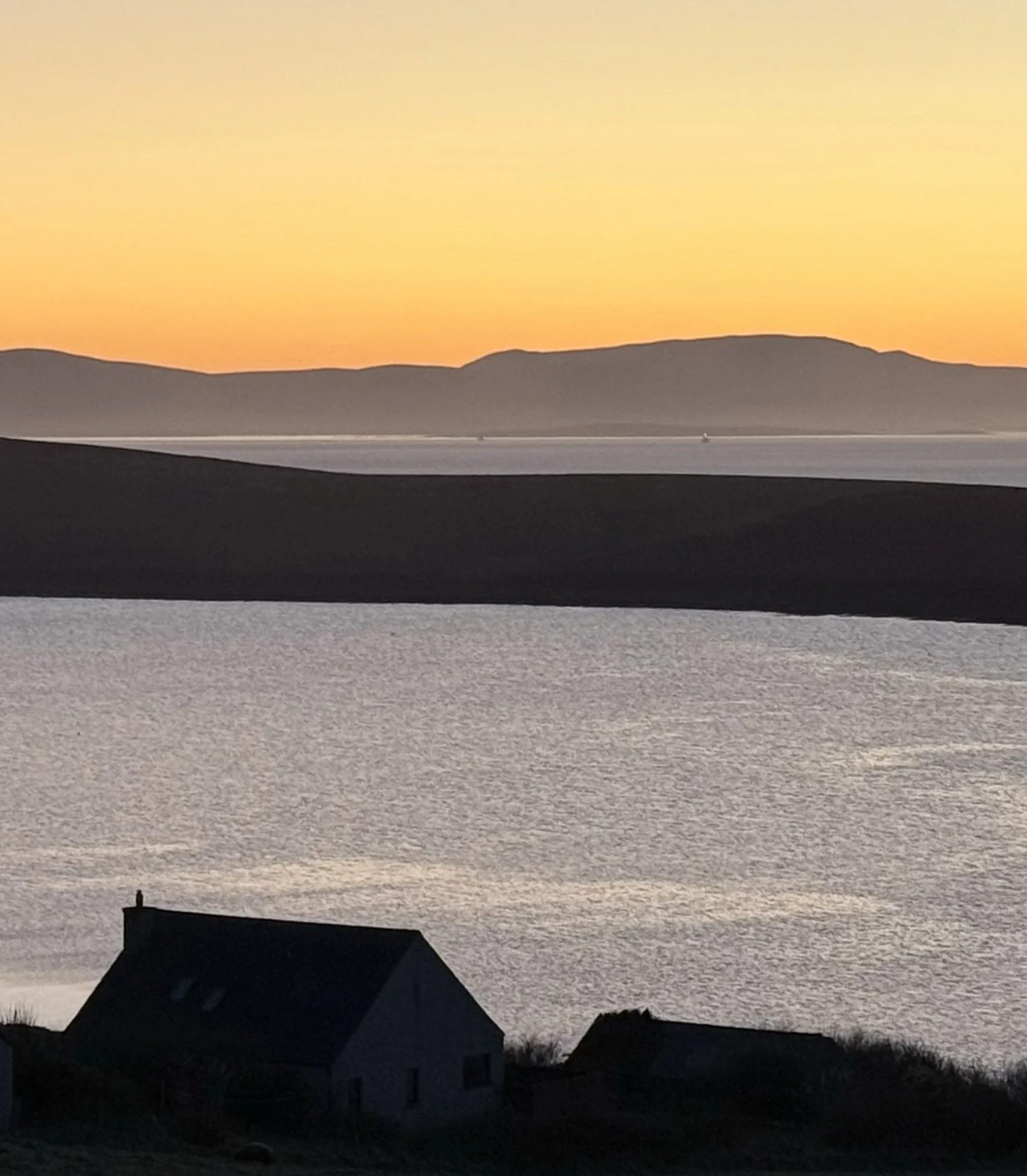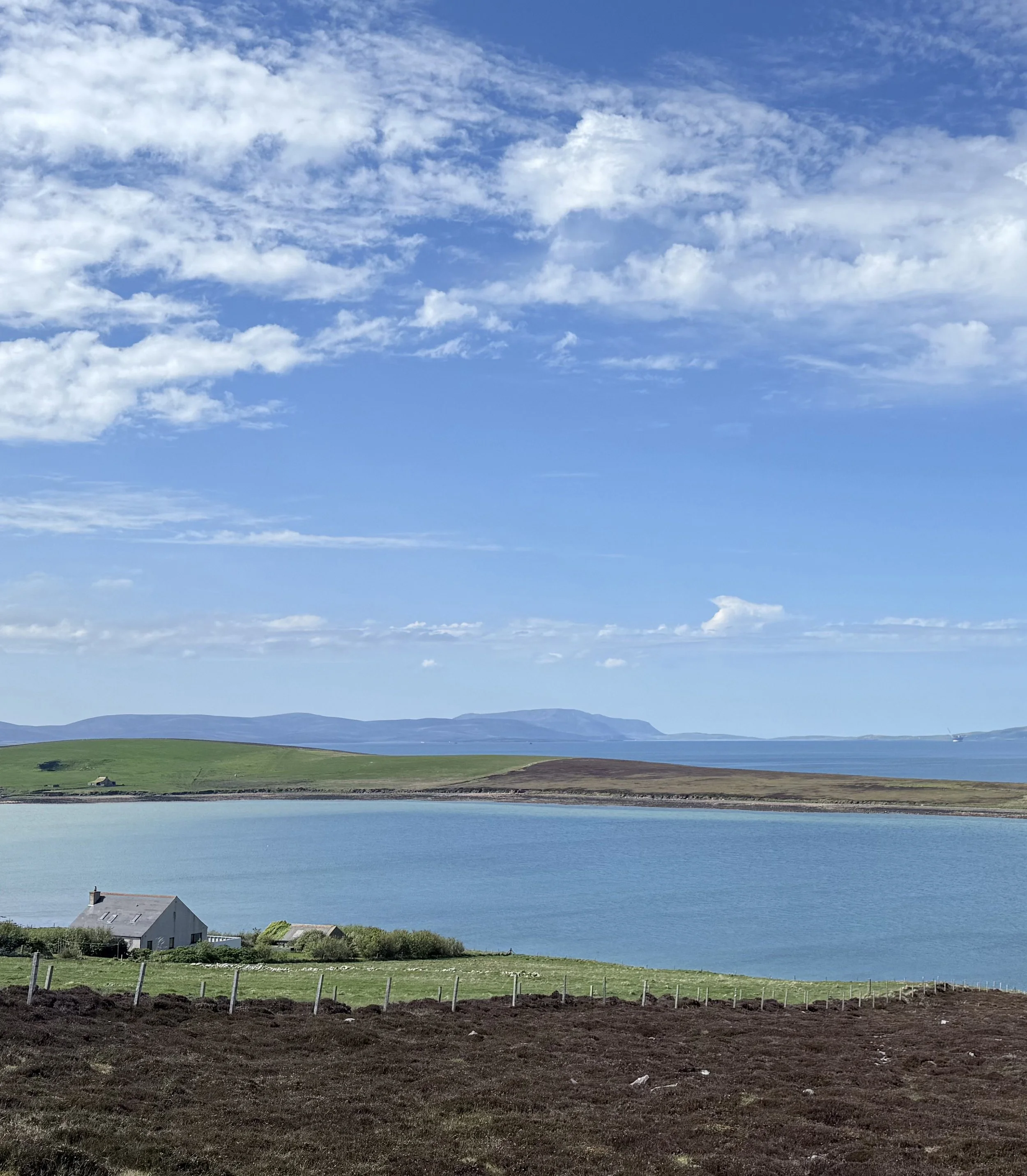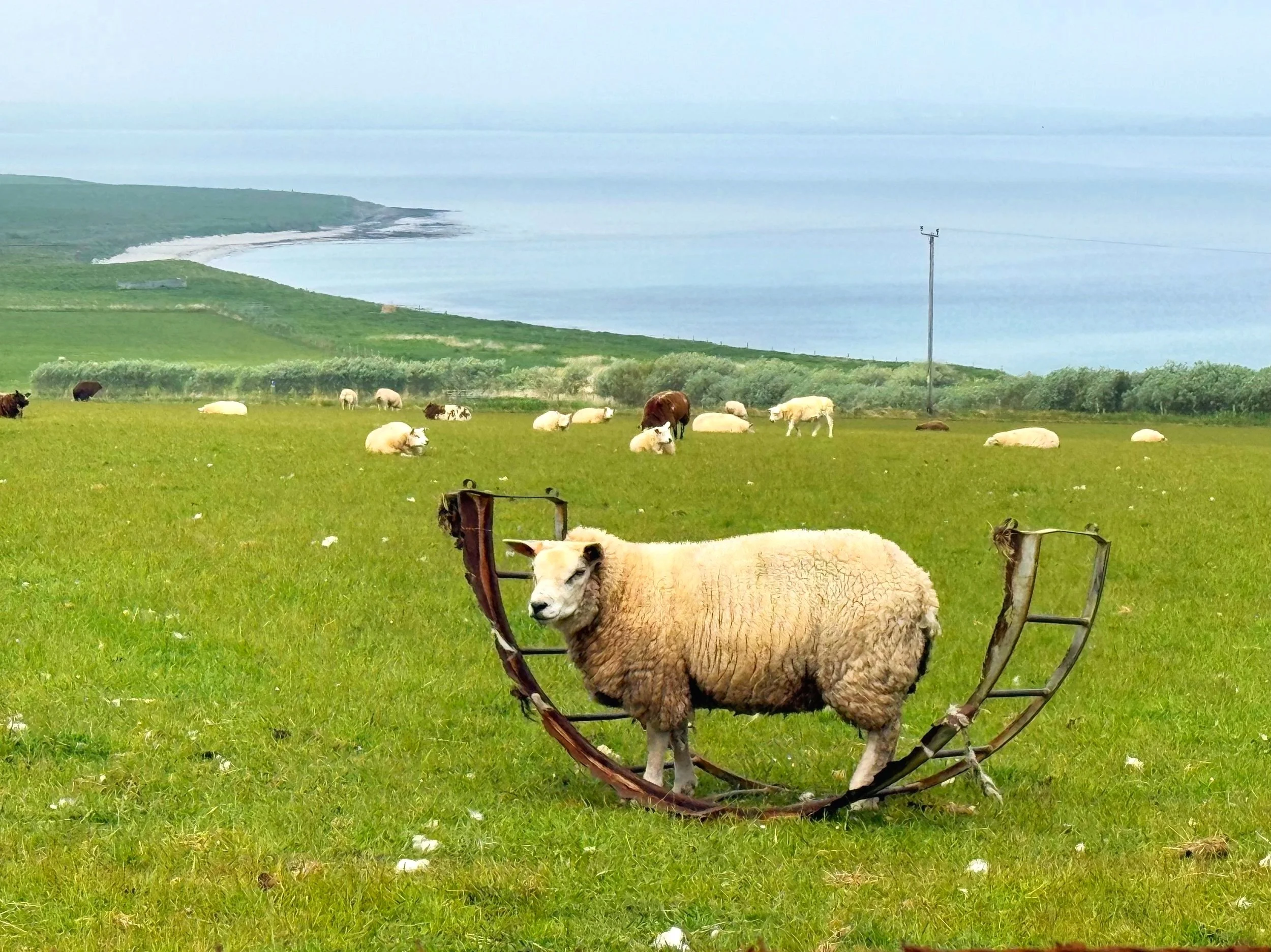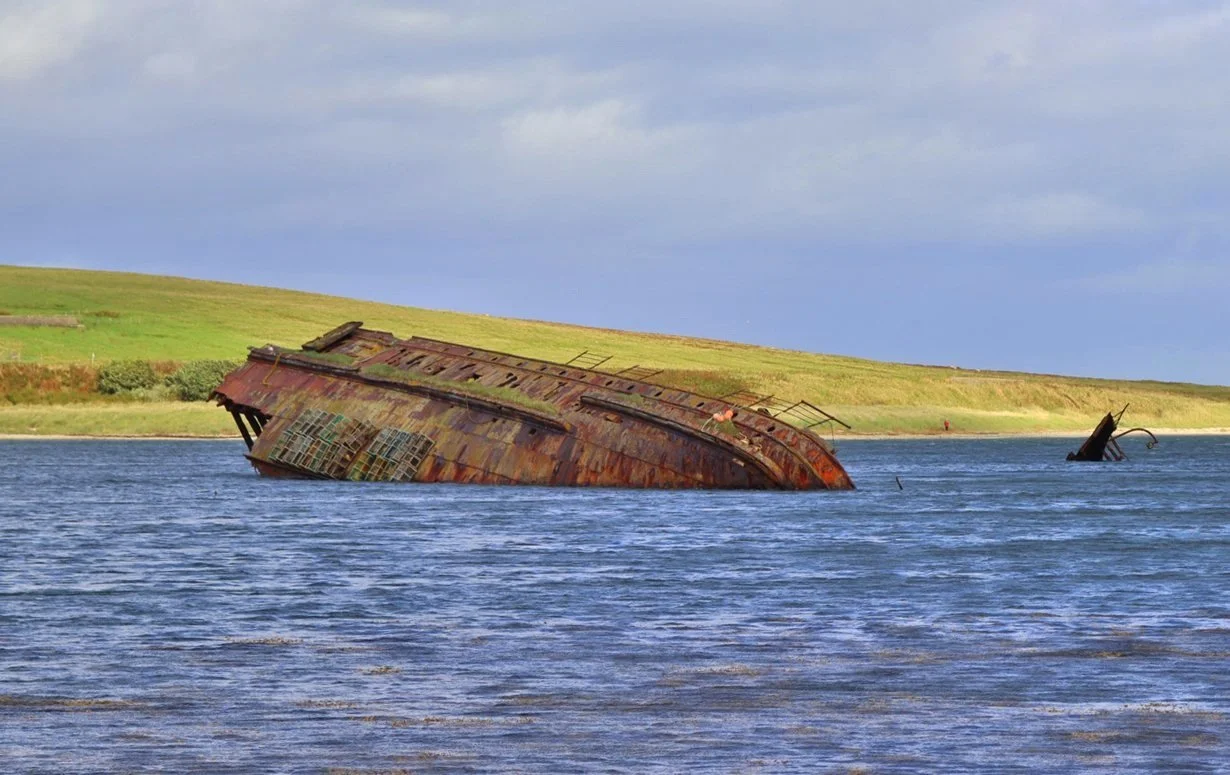A holiday cottage with spectacular sea views in mystical Orkney
"The peace and inner calm I feel at Vestley Banks is unmatched — it's my sanctuary away from the world."
About Vestley Banks
Imagine waking up to this breathtaking view every morning, smelling clean sea air, feeling a fresh breeze on your skin, and hearing nothing but sea birds and gentle waves. At Vestley Banks, you can do exactly that, as there are magnificent sea views from nearly every single window in the house, even the utility room.
Vestley Banks is an extended and renovated farming croft, with its original stone section believed to date from the 1800s. The two adjacent buildings you see are a detached garage and a historic stone outbuilding (there are no direct neighbours). Vestley Banks sits within lush fields, where you will often see sheep grazing- and heathlands. There is no traffic noise, only the sounds of wildlife. The location of the house is picture-perfect, offering complete peace and silence directly by the sea, yet it is less than a half-hour drive from the airport.
The house and its garden boast stunning 180-degree sea views, overlooking the famous Scapa Flow bay -a world-renowned divers’ destination- and has its own private shore. There are plenty of seabirds to observe, as well as occasional seals; even the odd dolphin and whale make their way into Scapa Flow. In the distance, you can see multiple other Orkney isles, including the beautiful mountains of Hoy island.
Vestley Banks is located on the peaceful north-western coast of the island of Burray, the third of four islands linked to the Orkney Mainland by a series of causeways, the renowned ‘Churchill Barriers’. This means you can drive to the house directly from the airport without having to take a ferry (unlike many of the other Orkney isles), despite being on a remote island with all its advantages.
Vestley Banks has three double bedrooms and three shower-rooms upstairs (two of which are en-suite), and a lovely snug that can be converted into a fourth double bedroom (plus an accessible family bathroom) downstairs. All four bedrooms have stunning sea views. Two of the bedrooms have super-king sized beds (convertible to twin beds, if needed), one is king sized (all high quality, orthopaedic hybrid mattresses), and the fourth is a double (convertible sofa bed with added gel mattress topper to ensure restful sleep). Our duvets and pillows are hypoallergenic, and our bed linen is white Egyptian cotton. Towels are supplied.
On the ground floor, there is a living room, a sunroom with breathtaking, 180-degree, ever-changing sea views, a kitchen (again, panoramic sea views) with a dining table for six (extendable to eight), and a utility room with washing machine and dryer (and arguably the most spectacular view of any utility room in the country…). The kitchen is equipped with dishwasher, microwave and air-fryer, in addition to gas hob, oven and grill. A small welcome pack consisting of Orkney produce will be provided. What also sets Vestley Banks apart is a large, four-person home office / art studio on the ground floor (including an optional standing desk), which makes the house a perfect escape to work ‘from home’. The house is equipped with WiFi and a flat-screen TV (to connect your Netflix or Amazon account).
“The sunsets at Vestley Banks are mesmerising. From the sunroom, you get constantly changing views as the sky and the sea evolve every evening — it's like being in the cinema.”
However, one of the most striking features of the house is a large terrace with awe-inspiring sea views that lends itself perfectly not only to relaxing with a cup of tea, but also to yoga or other forms of outdoor exercise (there are two yoga mats available in the house). There is also a detached garage with electric gate to keep your fishing / diving equipment save. Here, you can also relax in a large swinging egg chair, looking out onto the sea.
The interior design of Vestley Banks is clean and contemporary. It is ideal not only for families, but also for remote working, as well as for artists, writers, and meditation or yoga retreats.
Burray
Burray is one of the easily accessible Orkney Isles, thanks to its connection to the main island by one of the iconic Churchill Barriers. In contrast to many of the other Orkney isles, there’s no need to take a ferry to reach Burray from Orkney’s ‘mainland’; in fact, the journey from Kirkwall Airport to Burray is quicker than travelling to the north of the main island.
On Burray, you’ll find a welcoming restaurant and a café, as well as a beautiful sandy beach just five minutes away at Churchill Barrier No 4. Saint Margaret’s Hope -known locally as ‘the Hope’- is the third largest settlement in Orkney and only a ten-minute drive from Vestley Banks. In St Margaret’s Hope, you’ll find a post office, a small shop, a restaurant serving local seafood (The Murray Arms), and a lovely café (Robertson’s).
Kirkwall, the capital of Orkney, with all its amenities including a Tesco Superstore, is a 25-minute drive from the house. Kirkwall traces its roots back to the Viking era and features winding streets, traditional stone buildings, and a vibrant harbour. Be sure to visit St Magnus Cathedral, an architectural landmark built from red and yellow sandstone, and the historical heart of the town.
The name Burray comes from the Old Norse ‘Borgarey’, meaning ‘Broch Island’, a reference to the ancient stone towers that once stood on its north coast and served as landmarks for Viking sailors and early settlers. Archaeological discoveries on Burray include not just broch remains but also a chambered cairn containing human and dog skeletons, offering a fascinating glimpse into prehistoric Orkney.
The island’s agricultural heritage is evident, with livestock farming remaining important, and a history of kelp harvesting that once played a significant role in the local economy. Burray is also a paradise for nature enthusiasts, with rare plants such as oysterplant and Scots lovage thriving on the sandy beaches and dunes near Churchill Barrier No 4. The island is home to Orkney’s only breeding colony of the graceful little tern and is a great spot to watch short-eared owls hunting during daylight. The waters around Burray are rich in marine life, and boat trips from the island often encounter dolphins, porpoises, and occasionally whales such as minke, humpback, and orca.
From Vestley Banks, you can see the nearby island of Hunda, a small, uninhabited isle connected to Burray by a tide-dependent causeway. This makes for a beautiful nature walk starting from Burray village and is a peaceful spot to watch for otters and seals.
Burray
Burray is one of the easily accessible Orkney Isles, thanks to its connection to the main island by one of the iconic Churchill Barriers. In contrast to many of the other Orkney isles, there’s no need to take a ferry to reach Burray from Orkney’s ‘mainland’; in fact, the journey from Kirkwall Airport to Burray is quicker than travelling to the north of the main island.
On Burray, you’ll find a welcoming restaurant and a café, as well as a beautiful sandy beach just five minutes away at Churchill Barrier No 4. Saint Margaret’s Hope -known locally as ‘the Hope’- is the third largest settlement in Orkney and only a ten-minute drive from Vestley Banks. In St Margaret’s Hope, you’ll find a post office, a small shop, a restaurant serving local seafood (The Murray Arms), and a lovely café (Robertson’s).
Kirkwall, the capital of Orkney, with all its amenities including a Tesco Superstore, is a 40-minute drive from the house. Kirkwall traces its roots back to the Viking era and features winding streets, traditional stone buildings, and a vibrant harbour. Be sure to visit St Magnus Cathedral, an architectural landmark built from red and yellow sandstone, and the historical heart of the town.
The name Burray comes from the Old Norse ‘Borgarey’, meaning ‘Broch Island’, a reference to the ancient stone towers that once stood on its north coast and served as landmarks for Viking sailors and early settlers. Archaeological discoveries on Burray include not just broch remains but also a chambered cairn containing human and dog skeletons, offering a fascinating glimpse into prehistoric Orkney.
The island’s agricultural heritage is evident, with livestock farming remaining important, and a history of kelp harvesting that once played a significant role in the local economy. Burray is also a paradise for nature enthusiasts, with rare plants such as oysterplant and Scots lovage thriving on the sandy beaches and dunes near Churchill Barrier No 4. The island is home to Orkney’s only breeding colony of the graceful little tern and is a great spot to watch short-eared owls hunting during daylight. The waters around Burray are rich in marine life, and boat trips from the island often encounter dolphins, porpoises, and occasionally whales such as minke, humpback, and orca.
From Vestley Banks, you can see the nearby island of Hunda, a small, uninhabited isle connected to Burray by a tide-dependent causeway. This makes for a beautiful nature walk starting from Burray village and is a peaceful spot to watch for otters and seals.
Scapa Flow & The Churchill Barriers
When you drive to Vestley Banks via the Churchill Barriers, you’ll be struck by the sight of several shipwrecks rising from the water near the causeways. These are historic blockships, deliberately sunk during the Second World War to stop enemy submarines from entering Scapa Flow, which served as a crucial natural harbour for the Royal Navy. Today, some of these wrecks are popular spots for divers and snorkelers to explore.
Scapa Flow itself is one of the largest natural harbours in the world, spanning over 320 square kilometres. This sheltered bay has played a vital role in maritime history for centuries, first serving Viking longships over a thousand years ago. After World War I, dozens of German warships were scuttled here by their own crews to prevent capture, creating an extraordinary underwater graveyard.
These wrecks now support thriving marine life, from crabs and lobsters to starfish, sea urchins, and even rare species like the fan mussel and common skate. Horse mussel reefs have formed around some of the wrecks, making them hotspots for marine biodiversity. Scapa Flow is also a haven for birdlife, with species such as velvet scoters, horned grebes, shags, curlews, and black guillemots, while seals, otters, and occasionally orcas can be seen in the surrounding waters.
The Churchill Barriers themselves are a series of four causeways connecting Orkney Mainland to the islands of Lamb Holm, Glimps Holm, Burray, and South Ronaldsay. Built during the early 1940s on Winston Churchill’s orders, these impressive structures were constructed after a German submarine managed to breach the blockship defences and sink HMS Royal Oak. Massive quantities of rock and concrete were used to create the barriers, which today provide scenic and historic road links between the islands. As you travel along the barriers, you’ll pass beautiful beaches, spot seabirds and seals, and see remnants of wartime defences and shipwrecks along the way.
Vestley Banks sits right on the shore of Scapa Flow, offering guests not only a unique glimpse into Orkney’s remarkable history but also a front-row seat to some of the islands’ most spectacular natural and marine life.
Scapa Flow & The Churchill Barriers
When you drive to Vestley Banks via the Churchill Barriers, you’ll be struck by the sight of several shipwrecks rising from the water near the causeways. These are historic blockships, deliberately sunk during the Second World War to stop enemy submarines from entering Scapa Flow, which served as a crucial natural harbour for the Royal Navy. Today, some of these wrecks are popular spots for divers and snorkelers to explore.
Scapa Flow itself is one of the largest natural harbours in the world, spanning over 320 square kilometres. This sheltered bay has played a vital role in maritime history for centuries, first serving Viking longships over a thousand years ago. After World War I, dozens of German warships were scuttled here by their own crews to prevent capture, creating an extraordinary underwater graveyard.
These wrecks now support thriving marine life, from crabs and lobsters to starfish, sea urchins, and even rare species like the fan mussel and common skate. Horse mussel reefs have formed around some of the wrecks, making them hotspots for marine biodiversity. Scapa Flow is also a haven for birdlife, with species such as velvet scoters, horned grebes, shags, curlews, and black guillemots, while seals, otters, and occasionally orcas can be seen in the surrounding waters.
The Churchill Barriers themselves are a series of four causeways connecting Orkney Mainland to the islands of Lamb Holm, Glimps Holm, Burray, and South Ronaldsay. Built during the early 1940s on Winston Churchill’s orders, these impressive structures were constructed after a German submarine managed to breach the blockship defences and sink HMS Royal Oak. Massive quantities of rock and concrete were used to create the barriers, which today provide scenic and historic road links between the islands. As you travel along the barriers, you’ll pass beautiful beaches, spot seabirds and seals, and see remnants of wartime defences and shipwrecks along the way.
Vestley Banks sits right on the shore of Scapa Flow, offering guests not only a unique glimpse into Orkney’s remarkable history but also a front-row seat to some of the islands’ most spectacular natural and marine life.
Mystical Orkney
Orkney is a truly unique and authentic destination, steeped in thousands of years of history and culture. Once considered the centre of innovation for the British Isles, Orkney is renowned for its remarkable Neolithic heritage and is home to some of the best-preserved prehistoric sites in the world, such as Skara Brae-a 5000-year-old village that predates the Egyptian pyramids.
Today, Orkney is a UNESCO World Heritage Site thanks to its astonishing number of Neolithic sites. The landscape is dotted with ancient monuments, including the Ring of Brodgar, a 3000-year-old stone circle larger than Stonehenge, and Maeshowe, an ancient tomb also famous for its Viking graffiti left by Norsemen in the 12th century. Examples include “Haermund Hardaxe carved these runes” (runes are the Viking alphabet), a classic ‘I was here’ message left by a Viking visitor, as well as “Ingigerth is the most beautiful of all women”. Orkney was once a powerful seat in the Norse empire, and the Orkneyinga Saga tells many stories of its Viking heritage. This Viking legacy is still felt in Orkney today; many local place names are Scandinavian in origin, and genetic studies have shown that a significant number of Orcadians are descended from Norse settlers.
For centuries, Orkney’s strategic location made it a vital stopover for ships trading between Europe and America, serving as a key port for provisioning, repairs, and crew changes on transatlantic voyages. Orkney, and Scapa Flow in particular, also played a major strategic role in both the First and Second World Wars.
The native Orcadians are lovely, down-to-earth people with a live-and-let-live attitude. Due to its history (the Orkney Isles were Norwegian until 1468, when they were given to Scotland as part of a dowry arrangement), the islands now have a unique blend of Scottish and Scandinavian culture. Orkney’s flag, which bears a striking resemblance to Norway’s, is a testament to this Scandinavian connection.
Most importantly, Orkney boasts an extreme, raw beauty in its landscape and distinctive horizontality. Orkney is powerfully elemental, being close to wind and water. It feels somewhat liminal, with a mystical energy - there really is nothing quite like it.
Orkney is a unique paradise, perfect for relaxing and a complete reset. It is peaceful, slow-paced (‘Orkney time’), and has exquisitely clean air and water. There are great walks in nature, but it’s also ideal for working remotely. And all of this secluded bliss is a mere hour’s flight from Aberdeen, Edinburgh, Glasgow, or Dundee. What’s not to like?
Mystical Orkney
Orkney is a truly unique and authentic destination, steeped in thousands of years of history and culture. Once considered the centre of innovation for the British Isles, Orkney is renowned for its remarkable Neolithic heritage and is home to some of the best-preserved prehistoric sites in the world, such as Skara Brae-a 5000-year-old village that predates the Egyptian pyramids.
Today, Orkney is a UNESCO World Heritage Site thanks to its astonishing number of Neolithic sites. The landscape is dotted with ancient monuments, including the Ring of Brodgar, a 3000-year-old stone circle larger than Stonehenge, and Maeshowe, an ancient tomb also famous for its Viking graffiti left by Norsemen in the 12th century. Examples include “Haermund Hardaxe carved these runes” (runes are the Viking alphabet), a classic ‘I was here’ message left by a Viking visitor, as well as “Ingigerth is the most beautiful of all women”. Orkney was once a powerful seat in the Norse empire, and the Orkneyinga Saga tells many stories of its Viking heritage. This Viking legacy is still felt in Orkney today; many local place names are Scandinavian in origin, and genetic studies have shown that a significant number of Orcadians are descended from Norse settlers.
For centuries, Orkney’s strategic location made it a vital stopover for ships trading between Europe and America, serving as a key port for provisioning, repairs, and crew changes on transatlantic voyages. Orkney, and Scapa Flow in particular, also played a major strategic role in both the First and Second World Wars.
The native Orcadians are lovely, down-to-earth people with a live-and-let-live attitude. Due to its history (the Orkney Isles were Norwegian until 1468, when they were given to Scotland as part of a dowry arrangement), the islands now have a unique blend of Scottish and Scandinavian culture. Orkney’s flag, which bears a striking resemblance to Norway’s, is a testament to this Scandinavian connection.
Most importantly, Orkney boasts an extreme, raw beauty in its landscape and distinctive horizontality. Orkney is powerfully elemental, being close to wind and water. It feels somewhat liminal, with a mystical energy - there really is nothing quite like it.
Orkney is a unique paradise, perfect for relaxing and a complete reset. It is peaceful, slow-paced (‘Orkney time’), and has exquisitely clean air and water. There are great walks in nature, but it’s also ideal for working remotely. And all of this secluded bliss is a mere hour’s flight from Aberdeen, Edinburgh, Glasgow, or Dundee. What’s not to like?





